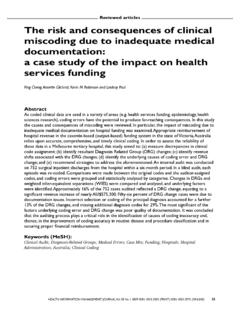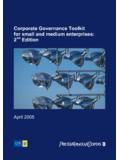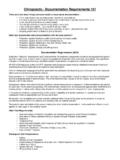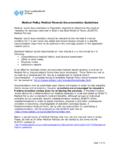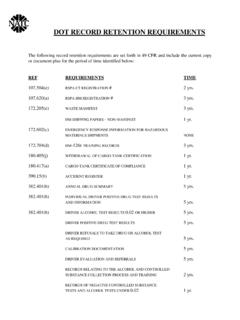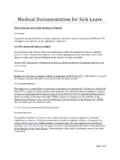Transcription of GENERAL CLINICAL DOCUMENTATION AND …
1 HIMAA Practice Brief 1 GENERAL DOCUMENTATION & Information requirements 1 of 42 December 2006 HIMAA PRACTICE BRIEF NO1 GENERAL CLINICAL DOCUMENTATION AND INFORMATION requirements DECEMBER 2006 HIMAA Practice Brief 1 GENERAL DOCUMENTATION & Information requirements 2 of 42 December 2006 TABLE OF CONTENTS INTENTION AND RECOMMENDED DOCUMENTATION HEALTH RECORD TABLE 1: Authentication of paper-based Legibility of Availability of the Accessibility of the Correction of Information and Version Requests for Change in Accordance with Freedom of Information ..14 TIMELINESS OF DOCUMENTATION / INFORMATION APPROPRIATE CONTENT OF DOCUMENTATION / Continuity of patient Legal Accountability Research, education and evaluation of ACCURATE AND OBJECTIVE DOCUMENTATION PRACTICE TABLE 2: CLINICAL DOCUMENTATION Medical Practitioner.
2 17 TABLE 3: DOCUMENTATION in progress notes - GENERAL ..24 TABLE 4: CLINICAL DOCUMENTATION - Nursing ..26 TABLE 5: Allied Health DOCUMENTATION ..28 TABLE 6: Non-admitted Patient TABLE 7: Diagnostic Reports ..31 TABLE 8: TABLE 9: Other Information requirements ..35 APPENDIX 1 Legal APPENDIX 2 List of Stakeholders HIMAA Practice Brief 1 GENERAL DOCUMENTATION & Information requirements 3 of 42 December 2006 ACKNOWLEDGEMENTS In developing this practice brief, the Health Information Management of Australia (HIMAA) would like to acknowledge: The Medical Record Advisory Unit, Funding and Information Management, South Australian Department of Health, for use of the document: South Australian Medical Record DOCUMENTATION and Data Capture Standards, August 2000. INTENTION AND SCOPE The intention of this practice brief (1) is to describe the GENERAL aspects of an acceptable standard of DOCUMENTATION and information capture in the health environment.
3 This brief can be utilised for quality assurance purposes, benchmarking, and to provide guidance in the design of health records, development of policies and procedures and good information management practices. In GENERAL the content of this practice brief has been developed for paper based health records however many of the issues are relevant to the electronic environment and where applicable, this has been noted. Where a combination of an electronic and paper-based record exists for a patient1, the information in both media should be cross-referenced so that the existence of each record and the record format is known. A standard approach should be adopted for cross referencing the existence of record formats for example, utilising a record tracking system, central registration system (such as the patient master index2) or alert system. The practice brief does not address the structure of the health record, nor does it attempt to address when a record should be created and what information besides CLINICAL content should form part of the record.
4 In addition issues regarding storage and dissemination of CLINICAL information in the electronic environment are not addressed here. It is intended that these issues and other specialist DOCUMENTATION and information capture requirements be explored in future practice briefs. This document has been prepared as a practice brief for information purposes and should not be interpreted as legal advice. It is not intended that the document over ride existing state or legislative requirements regarding the capture and recording of health information. 1 For the purposes of this practice brief, the term patient has been used. However, as this brief is intended to be used widely throughout the healthcare industry, the terms patient, client and resident may also be used synonymously. 2 The patient master index (PMI) is a database register that uniquely identifies all patient s who have received or are scheduled to receive a health service.
5 The PMI contains patient identifying information and demographic details. For more information see the glossary of terms. HIMAA Practice Brief 1 GENERAL DOCUMENTATION & Information requirements 4 of 42 December 2006 RECOMMENDED DOCUMENTATION POLICIES In order to maintain an acceptable standard of DOCUMENTATION it is recommended that each health service undertake the following. (a) Conduct an analysis of the relevant state / territory legal obligations and standards3 with regard to DOCUMENTATION and information capture requirements in health records. (b) Based on this analysis, develop a DOCUMENTATION and information capture policy that addresses: The process for authenticating entries in the record The process for ensuring the reliability of the information in the record. In particular: That the information is readable and can be understood That the record is available at a given point in time That the record is accessible in a format appropriate for the user That changes to information in the record are appropriately managed That user access to the record is managed Time frames for DOCUMENTATION The appropriate level of detail when documenting in the record The content of the is objective and reflects actual events (c) Develop policies that address dual record systems including management of paper based, electronic and departmental records.
6 (d) Undertake regular reviews to ensure policies are met and to implement appropriate action where deficiencies are identified. 3 A range of quality and accreditation bodies have developed standards for the evaluation of health records, these include but are not limited to Australian Council on Health care Standards, Quality Improvement & Community Services Accreditation, Royal Australian College of GENERAL Practitioners. HIMAA Practice Brief 1 GENERAL DOCUMENTATION & Information requirements 5 of 42 December 2006 GLOSSARY The following is a list of terms, associated definitions and concepts used in this practice brief. Inpatient (admitted patient) A patient who undergoes a health service s admission process to receive treatment and / or care. This treatment and / or care is provided over a period of time and can occur in health service and / or in the person s home (for hospital-in-the-home patients).
7 The patient may be admitted if one or more of the following apply: The patient s condition requires CLINICAL management and / or facilities not available in their usual residential environment The patient requires observation in order to be assessed or diagnosed The patient requires at least daily assessment of their medication needs The patient requires procedure(s) that cannot be performed in a stand-alone facility, such as a doctor s room without specialized support facilities and / or expertise available (eg. Cardiac catheterization) There is a legal requirement for admission (eg. Under child protection legislation) The patient is nine days old or less4 There are two types of admitted patients, overnight stay patients and same-day patients. A same day patient is one who is admitted and separated on the same date. An overnight stay patient is a patient who, following a CLINICAL decision, receives hospital treatment for a minimum of one night ie.
8 Who is admitted to and separated from the hospital on different dates. 4 AIHW, National Health Data Dictionary, version 12 HIMAA Practice Brief 1 GENERAL DOCUMENTATION & Information requirements 6 of 42 December 2006 Metadata5 Metadata needs to accompany data, otherwise the data being captured or communicated cannot be understood. For example, the value 123 can be transmitted in a data file. However it is meaningless without additional information to explain the context of the value. Is it a street number, a CLINICAL measurement, a test result or the number of services provided? Metadata usually gives data a unique identity in a given context. Metadata is required to describe the context, content and structure of health information that makes up a health record6. There is a range of metadata depending on the context in which the data is created. For example, record keeping metadata includes: Registration and classification metadata the metadata that gives a record its unique identity and classifies it in a classification scheme.
9 Content, structure and context metadata the metadata that gives a record content including title, abstract structure, type, format and context as well as identifying who created it, where, when and its relationship with other records. Recordkeeping process metadata metadata that provides information or evidence about processes a record may have undergone such as viewing, transmitting, transferring custody, accessing, reviewing, sentencing, changing etc7. NOTE: Australian Standard 5021:2005 The Language of Health Concept Representation is a useful reference document. Non-admitted patient A patient who does not undergo a formal admission process. There are three categories of non-admitted patient: Emergency department patient (unplanned contact) Outpatient (planned contact) Other non-admitted patient (treated by health service employees off the hospital site includes community / outreach 5 METeOR (meta data online registry) released by the Australian Institute of Health & Welfare in 2005 replaces the knowledge base as Australia's central repository for health, community services and housing assistance metadata and can be accessed from 6 AS ISO 15489 Records Management 2002 7 South Australian State Records.)
10 Recordkeeping Metadata (Recordkeeping Advice 017), March 2004, version 8 AIHW, National Health Data Dictionary, version 12 HIMAA Practice Brief 1 GENERAL DOCUMENTATION & Information requirements 7 of 42 December 2006 Patient Master Index (PMI) An index or database register that uniquely identifies all patients who have received or are scheduled to receive a health service by the organisation (or health enterprise) which may consist of one or more health care sites. It is called an index because it serves as a guide to each patient s health records by linking the patient s name to the unit record number (unique identifier). The PMI is the key to locating a patient s health information for continuing care purposes. The PMI contains patient identifying information and demographic details. A patient must be registered on the PMI if they: Are admitted to the health service Attend a non-admitted service for example, an outpatient clinic or emergency department, or are provided a community based service Where the intention is that the patient will receive a service in the future9.
